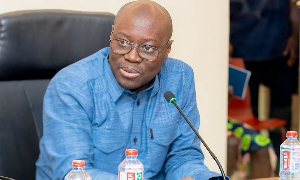In a little over three months? time, the United States government will release about $500 million for a five-year development projects in Ghana under the Millennium Challenge Account. Checks made by The Statesman indicate that within the three agricultural zones targeted by the government there are more than twice the number of constituencies controlled by the opposition than by the ruling party which have been selected to benefit from the fund. The project, covering three geographical zones, is estimated to benefit 50,000 farmers and 250,000 households, creating employment for 250,000 people. The beneficiaries are mainly smallholder farmers, but also include large-scale processors and export marketers.
While Government insists the selection criteria were purely based on socio-economic needs and agric-potential, the preponderance of National Democratic Congress controlled constituencies is causing some partisan unhappiness within the New Patriotic Party.
26 districts have been selected. Six of them are in the Northern Region: Tamale, Savelugu Nanton and Tolon Kumbungu are all NDC-controlled. NPP controls Gushiegu and Yendi. West Mamprusi will also benefit from the fund.
In the Southern Horticulture Area, 13 districts will benefit, with the majority in the Volta Region. They are Gomoa East (NPP), Manya Krobo (NDC), Yilo Krobo (NDC), North Dayi (NDC), Hohoe (NDC), Ketu (NDC), Keta (NDC), South Tongu, Akatsi, Dagme West (NDC) and Awutu Efutu Senya (NPP).
Within the Afram Basin, the areas to benefit are equally split between the two main parties. Ashanti Akim North (NPP), Kwahu South (NPP), Fanteakwa (NPP), Sekyere West (NDC), Ejura Sekyedumasi (NDC) and Afram Plains (NDC). Sekyere East will also benefit.
The MCA agricultural growth project, designed by government for Ghana, is an agricultural transformation programme. It involves transport infrastructure, social infrastructure and agricultural institutional infrastructure, with the aim to provide an enabling environment for the business of agriculture, focusing on the private sector.
Explaining the selection process to The Statesman, the Minister in charge of the project Papa Kwesi Nduom said, ?It has nothing to do with politics. Even if you want to have political arguments, there are more NDC districts than NPP. This has been done purely on national development policy with the single objective of success.?
But, this argument may still not go down well with some hard-line NPP members, who are already not particularly happy with the effects of the Public Procurement Act, which they believe is favouring contractors that had the partisan benefit under the NDC to build capacity and are now better placed to win government procurement contracts on merit.
There are two major selection criteria: one is the poverty profile of the district; the second is the growth potential of agriculture in the district. For example, a district like Bongo may be poor but the analysts found it had little agricultural potential, compared with the Afram Plains which, though poor, has enormous farming potential, with thousands of fertile acreage available and resourceful water bodies.
The third criterion used was proven success. Government looked at areas that the private sector or ?someone had invested with a proven result that could be used as demonstration or for expansion,? Dr Nduom said.
For example, the Integrated Tamale Fruit Company maintains a successful business at the Savelugu-Nanton district. They have planted organic mangoes, using over 100 smallholding out-growers. It is in its fourth year of operation but highly successful with each out-grower working a one-acre mango farm. The MCA project will help them expand, by providing them with irrigation, among other facilities. Down south, near Nsawam (Akwapim South District), is the Koranco Ltd, which operates over 1,000 acres of pineapple, pioneering the MD2 variety, which is currently more popular with exporters than the smooth local variety.
?We want to use them as an anchor to get more farmers in the area to grow the MD2 variety, as well,? the Minister for Public Sector Reform explained. The MCA projects will be managed by the Millennium Challenge Authority, a statutory body. It will coordinate, in conjunction with sector ministries, the technology outreach programme, irrigation, agribusiness capacity building and help the farmers with access to formal and informal lines of credit.
There will also be an integrated post-harvest infrastructural activity. For example, 385 km of trunk roads are to be constructed to provide increased accessibility to farmlands and markets in the Afram Basin, made up of Ejura Sekyedumase, Afram Plains, Fanteakwa and Kwahu South districts.
In the Central Region alone, 37 road links will be worked on, totaling 280 km. The Northern Region will benefit from 34 road links of 199 km in length; the Volta Region will have 34 road links totaling 225 km; with the Eastern Region getting 25 road links at 199 km.
In the Northern Region, at Savelugu-Nanton and Tolon-Kumbungu, 3,250 farmers from each of the districts are being targeted to grow mango and stable crops over a land mass of 13,000 hectares immediately the project kicks of; with diversification planned for avocado, figs, grapes and high value vegetables. Another 3,500 farmers are programmed to benefit in Tamale, at two hectares per farmer. In the Northern Agricultural Area selected, the number of smallholder farmers targeted is 10,000 to work on about 20,000 hectares of arable land. At the Afram basin, the largest potential food basket in the scheme, 25,920 farmers are planned to till 39,500 hectares. Specifically within the Afram Plains alone, 20,000 farmers will grow maize, yam, cassava, vegetables, and goundnuts and 25,000 hectares. They will be later encouraged to grow cashew nuts and shea nuts.
The Southern Horticultural Area will contribute another 11,250 farmers to the project on 11,250 hectares, making it a grand total of 47,170 farmers producing effectively on 70,750 hectares of land. Within the Southern zone, the Volta Region will most benefit with 5,000 farmers targeted at Ketu, Keta, South Tongu and Akatsi to grow stable crops and vegetables. Another 2,000 farmers from Dangme West, Maya Krobo, Yilo Krobo, North Dayi and Hohoes will also benefit.
Even the capital city is integrated in this comprehensive approach to farming, from planting seed to export. The N1 Highway which covers the 14 km from the Tetteh Quarshie Interchange to Mallam Junction has been determined to form an integral part of the road network from the agricultural centres in the southern horticulture area to the airport and sea port.
Each of the selected districts will have a customised program based on the priority food and horticultural crop priorities. Besides, there will be on-farm cooling capacity to reduce waste. This will be supported by independent pack houses with cooling capacity. There will also be an independent perishable cargo centre at the Kotoka International Airport.
Rural banks within the selected zones will be assisted in capacity building to deliver credit to the farmers.
General News of Wednesday, 26 April 2006
Source: Statesman












